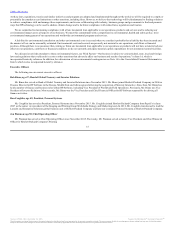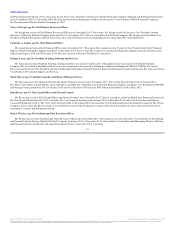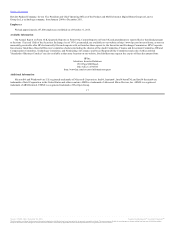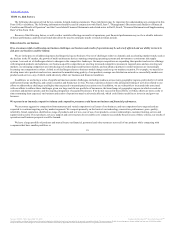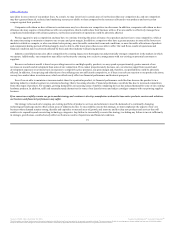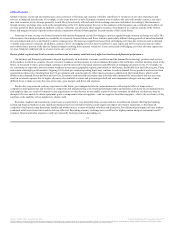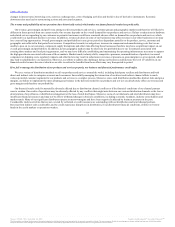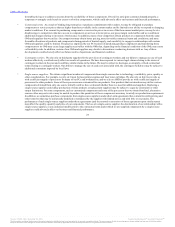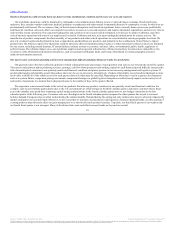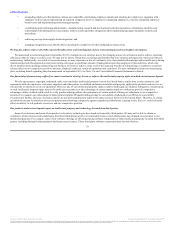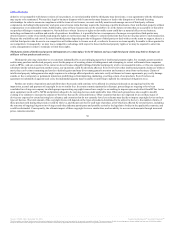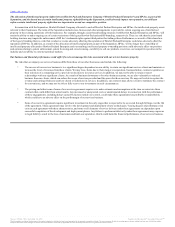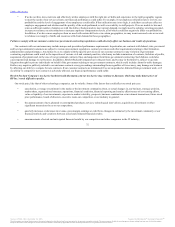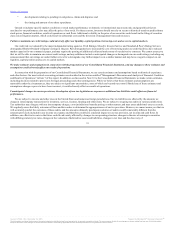HP 2015 Annual Report Download - page 25
Download and view the complete annual report
Please find page 25 of the 2015 HP annual report below. You can navigate through the pages in the report by either clicking on the pages listed below, or by using the keyword search tool below to find specific information within the annual report.
Table of Contents
Our inventory management is complex, as we continue to sell a significant mix of products through distributors. We must manage both owned and
channel inventory effectively, particularly with respect to sales to distributors, which involves forecasting demand and pricing challenges. Distributors may
increase orders during periods of product shortages, cancel orders if their inventory is too high or delay orders in anticipation of new products. Distributors
also may adjust their orders in response to the supply of our products and the products of our competitors and seasonal fluctuations in end-user demand. Our
reliance upon indirect distribution methods may reduce our visibility into demand and pricing trends and issues, and therefore make forecasting more
difficult. If we have excess or obsolete inventory, we may have to reduce our prices and write down inventory. Moreover, our use of indirect distribution
channels may limit our willingness or ability to adjust prices quickly and otherwise to respond to pricing changes by competitors. We also may have limited
ability to estimate future product rebate redemptions in order to price our products effectively.
We depend on third-party suppliers, and our financial results could suffer if we fail to manage our suppliers effectively.
Our operations depend on our ability to anticipate our needs for components, products and services, as well as our suppliers' ability to deliver sufficient
quantities of quality components, products and services at reasonable prices and in time for us to meet critical schedules for the delivery of our own products
and services. Given the wide variety of systems, products and services that we offer, the large number of our suppliers and contract manufacturers that are
located around the world, and the long lead times required to manufacture, assemble and deliver certain components and products, problems could arise in
production, planning and inventory management that could seriously harm our business. In addition, our ongoing efforts to optimize the efficiency of our
supply chain could cause supply disruptions and be more expensive, time-consuming and resource intensive than expected. Furthermore, certain of our
suppliers may decide to discontinue conducting business with us. Other supplier problems that we could face include component shortages, excess supply,
risks related to the terms of our contracts with suppliers, risks associated with contingent workers and risks related to our relationships with single source
suppliers, each of which is described below.
• We may experience a shortage of, or a delay in receiving, certain components as a result of strong demand, capacity
constraints, supplier financial weaknesses, the inability of suppliers to borrow funds in the credit markets, disputes with suppliers (some of
whom are also our customers), disruptions in the operations of component suppliers, other problems experienced by suppliers or problems
faced during the transition to new suppliers. For example, our PC business relies heavily upon OMs to manufacture its products and is
therefore dependent upon the continuing operations of those OMs to fulfill demand for our PC products. We represent a substantial portion of
the business of some of these OMs, and any changes to the nature or volume of our business transactions with a particular OM could adversely
affect the operations and financial condition of the OM and lead to shortages or delays in receiving products from that OM. If shortages or
delays persist, the price of certain components may increase, we may be exposed to quality issues or the components may not be available at
all. We may not be able to secure enough components at reasonable prices or of acceptable quality to build products or provide services in a
timely manner in the quantities needed or according to our specifications. Accordingly, our business and financial performance could suffer if
we lose time-sensitive sales, incur additional freight costs or are unable to pass on price increases to our customers. If we cannot adequately
address supply issues, we might have to reengineer some product or service offerings, which could result in further costs and delays.
• In order to secure components for our products or services, at times we may make advance payments to suppliers or enter into
non-cancelable commitments with vendors. In addition, we may purchase components strategically in advance of demand to take advantage of
23
Source: HP INC, 10-K, December 16, 2015 Powered by Morningstar® Document Research℠
The information contained herein may not be copied, adapted or distributed and is not warranted to be accurate, complete or timely. The user assumes all risks for any damages or losses arising from any use of this information,
except to the extent such damages or losses cannot be limited or excluded by applicable law. Past financial performance is no guarantee of future results.




